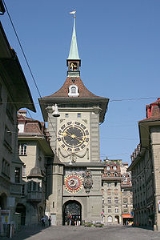
Zytglogge
Encyclopedia
The Zytglogge tower is a landmark
medieval tower
in Bern, Switzerland
. Built in the early 13th century, it has served the city as guard tower
, prison
, clock tower
, centre of urban life and civic memorial
.
Despite the many redecorations and renovations it has undergone in its 800 years of existence, the Zytglogge is one of Bern's most recognisable symbols and, with its 15th-century astronomical clock
, a major tourist attraction. It is a heritage site of national significance
, and part of the Old City of Bern, a UNESCO
World Cultural Heritage site.
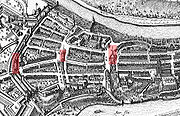 When it was built around 1218–20, the Zytglogge served as the gate tower of Bern's western fortifications. These were erected after the city's first westward expansion following its de facto independence
When it was built around 1218–20, the Zytglogge served as the gate tower of Bern's western fortifications. These were erected after the city's first westward expansion following its de facto independence
from the Empire
. At that time, the Zytglogge was a squat building of only 16 metres (52.5 ft) in height. When the rapid growth of the city and the further expansion of the fortifications (up to the Käfigturm) relegated the tower to second-line status at around 1270–75, it was heightened by 7 metres (23 ft) to overlook the surrounding houses.
Only after the city's western defences were extended again in 1344–46 up to the now-destroyed Christoffelturm
, the Zytglogge was converted to a women's prison, notably housing Pfaffendirnen – "priests' whores", women convicted of sexual relations with clerics. At this time, the Zytglogge also received its first slanted roof.
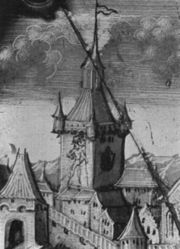 In the great fire of 1405, the tower burnt out completely. It suffered severe structural damage that required thorough repairs, which were not complete until after the last restoration in 1983. The prison cells were abandoned and a clock
In the great fire of 1405, the tower burnt out completely. It suffered severe structural damage that required thorough repairs, which were not complete until after the last restoration in 1983. The prison cells were abandoned and a clock
was first installed above the gate in the early 15th century, probably including a simple astronomical clock and musical mechanism. This clock, together with the great bell
cast in 1405, gave the Zytglogge its name, which in Bernese German
means "time bell".
In the late 15th century, the Zytglogge and the other Bernese gate towers were extended and decorated after the Burgundian
Romantic fashion. The Zytglogge received a new lantern (including the metal bellman visible today), four decorative corner towerlets, heraldic decorations and probably its stair tower. The astronomical clock was extended to its current state. In 1527–30, the clockwork was completely rebuilt by Kaspar Brunner
, and the gateway was overarched to provide a secure foundation for the heavy machinery.
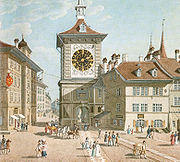 The Zytglogge's exterior was repainted by Gotthard Ringgli and Kaspar Haldenstein in 1607–10, who introduced the large clock faces that now dominate the east and west façades of the tower. The corner towerlets were removed again some time before 1603. In 1770–71, the Zytglogge was renovated by Niklaus Hebler and Ludwig Emanuel Zehnder, who refurbished the structure in order to suit the tastes of the late Baroque
The Zytglogge's exterior was repainted by Gotthard Ringgli and Kaspar Haldenstein in 1607–10, who introduced the large clock faces that now dominate the east and west façades of the tower. The corner towerlets were removed again some time before 1603. In 1770–71, the Zytglogge was renovated by Niklaus Hebler and Ludwig Emanuel Zehnder, who refurbished the structure in order to suit the tastes of the late Baroque
, giving the tower its contemporary outline.
Both façades were again repainted in the Rococo
style by Rudolf von Steiger in 1890. The idealising historicism
of the design came to be disliked in the 20th century, and a 1929 competition produced the façade designs visible today: on the west façade, Viktor Surbek
's fresco "Beginning of Time" and on the east façade, a reconstruction of the 1770 design by Kurt Indermühle. In 1981–83, the Zytglogge was thoroughly renovated again and generally restored to its 1770 appearance. In the advent
season and from Easter
until the end of October, it is illuminated after dusk
.
and to time
bell in English
; 'Glocke' means 'bell' in German, as in the related term 'glockenspiel
'. A "time bell" was one of the earliest public timekeeping devices, consisting of a clockwork
connected to a hammer that rang a small bell at the full hour. Such a device was installed in the Wendelstein in Bern – the tower of the Leutkirche church which the Münster later replaced – in 1383 at the latest; it alerted the bell-ringer to ring the tower bells.
The name of Zytglogge was first recorded in 1413. Previously, the tower was referred to as the kebie ("cage", i.e., prison) and after its post-1405 reconstruction, the nüwer turm ("new tower").
 The Zytglogge has an overall height of 54.5 metres (178.8 ft), and a height of 24 metres (78.7 ft) up to the roof-edge. Its rectangular floor plan measures 11.2 by. The wall strengths vary widely, ranging from 260 centimetres (102.4 in) in the west, where the tower formed part of the city walls, to 65 centimetres (25.6 in) in the east.
The Zytglogge has an overall height of 54.5 metres (178.8 ft), and a height of 24 metres (78.7 ft) up to the roof-edge. Its rectangular floor plan measures 11.2 by. The wall strengths vary widely, ranging from 260 centimetres (102.4 in) in the west, where the tower formed part of the city walls, to 65 centimetres (25.6 in) in the east.
The outward appearance of the Zytglogge is determined by the 1770 renovation. Only the late Gothic
cornice
below the roof and the stair tower are visible artifacts of the tower's earlier history.
The main body of the tower is divided into the two-storey plinth
, whose exterior is made of alpine limestone
, and the three-storey tower shaft sheathed in sandstone
. The shaft's seemingly massive corner blocks are decorative fixtures held in place by visible iron hooks. Below the roof, the cornice spans around the still-visible bases of the former corner towerlets. The two-story attic
is covered by the sweeping, red-tiled, late Gothic spire
, in which two spire light
s are set to the West and East. They are crowned by ornamental urn
s with pinecone knobs reconstructed in 1983 from 18th-century drawings.
From atop the spire, the wooden pinnacle
, copper
-sheathed since 1930, rises an additional 15 metres (49.2 ft) into the skies, crowned with a gilded knob and a weather vane
displaying a cut-out coat of arms of Bern.
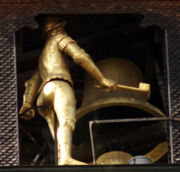 The tower's two namesake bronze
The tower's two namesake bronze
bells hang in the cupola
at its very top.
The great hour bell, cast by Johann Reber, has remained unchanged since the tower's reconstruction in 1405. It has a diameter of 127 centimetres (50 in), a weight of 1400 kilograms (3,086.5 lb) and rings with a nominal tone of e. The inscription on the bell reads, in Latin
: In the October month of the year 1405 I was cast by Master John called Reber of Aarau
. I am vessel and wax, and to all I tell the hours of the day.
When the great bell rings out every full hour, struck by a large clockwork-operated hammer, passers-by see a gilded figure in full harness moving its arm to strike it. The larger-than-life figure of bearded Chronos
, the Greek personification of time, is traditionally nicknamed Hans von Thann
by the Bernese. The wooden bell-striker
, which has been replaced several times, has been a fixture of the Zytglogge since the renewal of the astronomical clock in 1530, whose clockwork also controls the figure's motions. The original wooden Chronos might have been created by master craftsman Albrecht von Nürnberg
, while the current and most recent Hans is a 1930 reconstruction of a Baroque original. The bell-striker has been gilded, just like the bells, since 1770.
Below the hour bell hangs the smaller quarter-hour bell, also rung by a clockwork hammer. It was cast in 1887 to replace the cracked 1486 original.


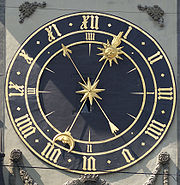
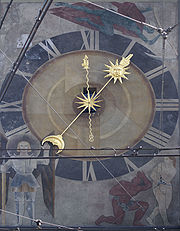
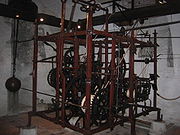 Both principal façades, East and West, are dominated by massive clockfaces. The Zytglogge's first clockface was likely located on the plinth, but was moved up to the center of the shaft during the tower's 15th-century reconfiguration.
Both principal façades, East and West, are dominated by massive clockfaces. The Zytglogge's first clockface was likely located on the plinth, but was moved up to the center of the shaft during the tower's 15th-century reconfiguration.
The eastern clock face features an outer ring of large golden Roman numerals
, on which the larger hand indicates the hour, and an inner ring on which the smaller hand indicates the minutes. The golden sun on the hour hand is pivot-mounted so that it always faces up. Below the clock face one sees an idealised profile of city founder Duke Berchtold V of Zähringen
. While the exact decoration of the clockface has varied from renovation to renovation, the current (post-1983) layout is generally that of 1770.
The western clock face has similar hands, but is an integral part of Viktor Surbek's 1929 fresco
"Beginning of Time". The painting depicts Chronos swooping down with cape fluttering, and, below the clockface, Adam and Eve
's eviction from Paradise
by an angel
.
of the Zytglogge's astronomical clock is built in the form of an astrolabe
. It is backed by a stereographically projected
planisphere
divided into three zones: the black night sky, the deep blue zone of dawn
and the light blue day sky. The skies are crisscrossed with the golden lines of the horizon
, dawn, the tropics and the temporal hours, which divide the time of daylight into twelve hours whose length varies with the time of year.
Around the planisphere moves the rete, a web-like metal cutout representing the zodiac
, which also features a Julian calendar
dial. Above the rete, a display indicates the day of the week. Because leap days are not supported by the clockwork, the calendar hand has to be reset manually each leap year
on 29 February. A moon dial circles the inner ring of the zodiac, displaying the moon phase. The principal hand of the clock indicates the time of day on the outer ring of 24 golden Roman numerals, which run twice from I to XII. It features two suns, the smaller one indicating the date on the retes calendar dial. The larger one circles the zodiac at one revolution per year and also rotates across the planisphere once per day. Its crossing of the horizon and dawn lines twice per day allows the timing of sunrise, dawn, dusk and sunset.
The painted frieze
above the astronomical clock shows five deities from classical antiquity, each representing both a day of the week and a planet in their order according to Ptolemaic cosmology. From left to right, they are: Saturn
with sickle and club for Saturday, Jupiter
with thunderbolts for Thursday, Mars
with sword and shield for Tuesday, Venus
with Cupid
for Friday and Mercury
with staff and bag for Wednesday. The painting of the entire clock area was refurbished in 1983. Only the matte areas on the clock face are from the earlier coat of paint.
A clock is documented in this tower since 1405, when a new bell was installed. The city accounts of 1438 mention the repair of the clockworks. The first mention of a dial is in 1443, and the first known image of the, much smaller first astrolabium dial (in the diary a cobbler journeyman from Ulm) is dated 1534. The jacquemart (bellstriker)
is also documented in the same 1534 source. In the first two decades of the sixteenth century many craftsman unsuccessfully tried to improve the clockworks. The current movement
was made in 1530 by clockmaker Kasper Bruner and is dated and signed by a forged nameplate. No other clockworks by this master are known. The core of the movement was forged in-situ, in the very room it is still located, and the fire pit of the forge remains in the room. One of the more unusual features of the movement is that each individual tooth of the major gears is removable (i.e.replaceable as it wears). Originally the movement had a verge escapement
with a foliot
, as it was built 127 years before the pendulum clock
was invented. The Zytglogge movement was converted to a much more accurate pendulum mechanism by the French clockmaker Pierre Angely between 1686 and 1688. The current pendulum bob, a "recycled" iron cannon ball, possibly dates from that time. The pendulum suspension is made from leather rather than using a metal spring. The weight-driven movement is wound daily by hand. That task, a role known as the "Zytgloggenrichter", has been held been held for over 25 years by the same individual.
The rooms above the clockwork mechanism were used by the city administration for various purposes up until the late 20th century, including as archives, storerooms, as a firehose magazine and even as an air raid shelter. The interior was frequently remodel[ed in a careless, even vandalistic fashion; for instance, all but three of the original wooden beams supporting the intermediate floors were destroyed. Since 1979, the tower's interior is empty again. It is only accessed for maintenance and in the course of regular guided tours.
.png)
Landmark
This is a list of landmarks around the world.Landmarks may be split into two categories - natural phenomena and man-made features, like buildings, bridges, statues, public squares and so forth...
medieval tower
Tower
A tower is a tall structure, usually taller than it is wide, often by a significant margin. Towers are distinguished from masts by their lack of guy-wires....
in Bern, Switzerland
Switzerland
Switzerland name of one of the Swiss cantons. ; ; ; or ), in its full name the Swiss Confederation , is a federal republic consisting of 26 cantons, with Bern as the seat of the federal authorities. The country is situated in Western Europe,Or Central Europe depending on the definition....
. Built in the early 13th century, it has served the city as guard tower
Defensive wall
A defensive wall is a fortification used to protect a city or settlement from potential aggressors. In ancient to modern times, they were used to enclose settlements...
, prison
Prison
A prison is a place in which people are physically confined and, usually, deprived of a range of personal freedoms. Imprisonment or incarceration is a legal penalty that may be imposed by the state for the commission of a crime...
, clock tower
Clock tower
A clock tower is a tower specifically built with one or more clock faces. Clock towers can be either freestanding or part of a church or municipal building such as a town hall. Some clock towers are not true clock towers having had their clock faces added to an already existing building...
, centre of urban life and civic memorial
Memorial
A memorial is an object which serves as a focus for memory of something, usually a person or an event. Popular forms of memorials include landmark objects or art objects such as sculptures, statues or fountains, and even entire parks....
.
Despite the many redecorations and renovations it has undergone in its 800 years of existence, the Zytglogge is one of Bern's most recognisable symbols and, with its 15th-century astronomical clock
Astronomical clock
An astronomical clock is a clock with special mechanisms and dials to display astronomical information, such as the relative positions of the sun, moon, zodiacal constellations, and sometimes major planets.-Definition:...
, a major tourist attraction. It is a heritage site of national significance
Swiss Inventory of Cultural Property of National and Regional Significance
The Swiss Inventory of Cultural Property of National and Regional Significance is a register of some 8,300 items of cultural property in Switzerland...
, and part of the Old City of Bern, a UNESCO
UNESCO
The United Nations Educational, Scientific and Cultural Organization is a specialized agency of the United Nations...
World Cultural Heritage site.
History

Golden Charter of Bern
The Golden Charter of Bern is a medieval charter purporting to have been issued by Holy Roman Emperor Frederick II. It establishes the town privileges of Bern , making it an Imperial Free City and, effectively, an independent state...
from the Empire
Holy Roman Empire
The Holy Roman Empire was a realm that existed from 962 to 1806 in Central Europe.It was ruled by the Holy Roman Emperor. Its character changed during the Middle Ages and the Early Modern period, when the power of the emperor gradually weakened in favour of the princes...
. At that time, the Zytglogge was a squat building of only 16 metres (52.5 ft) in height. When the rapid growth of the city and the further expansion of the fortifications (up to the Käfigturm) relegated the tower to second-line status at around 1270–75, it was heightened by 7 metres (23 ft) to overlook the surrounding houses.
Only after the city's western defences were extended again in 1344–46 up to the now-destroyed Christoffelturm
Christoffelturm
The Christoffelturm was a tower built between the years 1344 and 1346. It was located in the old part of the Swiss city of Bern, in the upper section of Spitalgasse, near Holy Spirit Church....
, the Zytglogge was converted to a women's prison, notably housing Pfaffendirnen – "priests' whores", women convicted of sexual relations with clerics. At this time, the Zytglogge also received its first slanted roof.

Clock
A clock is an instrument used to indicate, keep, and co-ordinate time. The word clock is derived ultimately from the Celtic words clagan and clocca meaning "bell". A silent instrument missing such a mechanism has traditionally been known as a timepiece...
was first installed above the gate in the early 15th century, probably including a simple astronomical clock and musical mechanism. This clock, together with the great bell
Bell (instrument)
A bell is a simple sound-making device. The bell is a percussion instrument and an idiophone. Its form is usually a hollow, cup-shaped object, which resonates upon being struck...
cast in 1405, gave the Zytglogge its name, which in Bernese German
Bernese German
Bernese German is the dialect of High Alemannic German spoken in the Swiss plateau part of the canton of Bern and in some neighbouring regions.- Varieties :There is a lot of regional variation within Bernese German dialects...
means "time bell".
In the late 15th century, the Zytglogge and the other Bernese gate towers were extended and decorated after the Burgundian
Duchy of Burgundy
The Duchy of Burgundy , was heir to an ancient and prestigious reputation and a large division of the lands of the Second Kingdom of Burgundy and in its own right was one of the geographically larger ducal territories in the emergence of Early Modern Europe from Medieval Europe.Even in that...
Romantic fashion. The Zytglogge received a new lantern (including the metal bellman visible today), four decorative corner towerlets, heraldic decorations and probably its stair tower. The astronomical clock was extended to its current state. In 1527–30, the clockwork was completely rebuilt by Kaspar Brunner
Kaspar Brunner
Kaspar Brunner was a Swiss mechanic best known for his construction of the clockwork of the Zytglogge, Bern's medieval clock-tower, in 1527–30....
, and the gateway was overarched to provide a secure foundation for the heavy machinery.

Baroque
The Baroque is a period and the style that used exaggerated motion and clear, easily interpreted detail to produce drama, tension, exuberance, and grandeur in sculpture, painting, literature, dance, and music...
, giving the tower its contemporary outline.
Both façades were again repainted in the Rococo
Rococo
Rococo , also referred to as "Late Baroque", is an 18th-century style which developed as Baroque artists gave up their symmetry and became increasingly ornate, florid, and playful...
style by Rudolf von Steiger in 1890. The idealising historicism
Historicism (art)
Historicism refers to artistic styles that draw their inspiration from copying historic styles or artisans. After neo-classicism, which could itself be considered a historicist movement, the 19th century saw a new historicist phase marked by a return to a more ancient classicism, in particular in...
of the design came to be disliked in the 20th century, and a 1929 competition produced the façade designs visible today: on the west façade, Viktor Surbek
Viktor Surbek
Viktor Surbek was a Swiss painter from Berne.After studies in Italy, Germany and Paris , he married fellow painter Marguerite Frey in 1914 and operated a painting school with her up until 1931. Surbek travelled widely and displayed his works at numerous expositions after 1905...
's fresco "Beginning of Time" and on the east façade, a reconstruction of the 1770 design by Kurt Indermühle. In 1981–83, the Zytglogge was thoroughly renovated again and generally restored to its 1770 appearance. In the advent
Advent
Advent is a season observed in many Western Christian churches, a time of expectant waiting and preparation for the celebration of the Nativity of Jesus at Christmas. It is the beginning of the Western liturgical year and commences on Advent Sunday, called Levavi...
season and from Easter
Easter
Easter is the central feast in the Christian liturgical year. According to the Canonical gospels, Jesus rose from the dead on the third day after his crucifixion. His resurrection is celebrated on Easter Day or Easter Sunday...
until the end of October, it is illuminated after dusk
Dusk
Dusk is the beginning of darkness in the evening, and occurs after twilight, when the sky generally remains bright and blue. Civil dusk is when the earth has rotated enough that the center of the sun is at 6° below the local horizon...
.
Name
The Bernese German Zytglogge translates to Zeitglocke in Standard GermanStandard German
Standard German is the standard variety of the German language used as a written language, in formal contexts, and for communication between different dialect areas...
and to time
Time
Time is a part of the measuring system used to sequence events, to compare the durations of events and the intervals between them, and to quantify rates of change such as the motions of objects....
bell in English
English language
English is a West Germanic language that arose in the Anglo-Saxon kingdoms of England and spread into what was to become south-east Scotland under the influence of the Anglian medieval kingdom of Northumbria...
; 'Glocke' means 'bell' in German, as in the related term 'glockenspiel
Glockenspiel
A glockenspiel is a percussion instrument composed of a set of tuned keys arranged in the fashion of the keyboard of a piano. In this way, it is similar to the xylophone; however, the xylophone's bars are made of wood, while the glockenspiel's are metal plates or tubes, and making it a metallophone...
'. A "time bell" was one of the earliest public timekeeping devices, consisting of a clockwork
Clockwork
A clockwork is the inner workings of either a mechanical clock or a device that operates in a similar fashion. Specifically, the term refers to a mechanical device utilizing a complex series of gears....
connected to a hammer that rang a small bell at the full hour. Such a device was installed in the Wendelstein in Bern – the tower of the Leutkirche church which the Münster later replaced – in 1383 at the latest; it alerted the bell-ringer to ring the tower bells.
The name of Zytglogge was first recorded in 1413. Previously, the tower was referred to as the kebie ("cage", i.e., prison) and after its post-1405 reconstruction, the nüwer turm ("new tower").
External structure

The outward appearance of the Zytglogge is determined by the 1770 renovation. Only the late Gothic
Gothic architecture
Gothic architecture is a style of architecture that flourished during the high and late medieval period. It evolved from Romanesque architecture and was succeeded by Renaissance architecture....
cornice
Cornice
Cornice molding is generally any horizontal decorative molding that crowns any building or furniture element: the cornice over a door or window, for instance, or the cornice around the edge of a pedestal. A simple cornice may be formed just with a crown molding.The function of the projecting...
below the roof and the stair tower are visible artifacts of the tower's earlier history.
The main body of the tower is divided into the two-storey plinth
Plinth
In architecture, a plinth is the base or platform upon which a column, pedestal, statue, monument or structure rests. Gottfried Semper's The Four Elements of Architecture posited that the plinth, the hearth, the roof, and the wall make up all of architectural theory. The plinth usually rests...
, whose exterior is made of alpine limestone
Limestone
Limestone is a sedimentary rock composed largely of the minerals calcite and aragonite, which are different crystal forms of calcium carbonate . Many limestones are composed from skeletal fragments of marine organisms such as coral or foraminifera....
, and the three-storey tower shaft sheathed in sandstone
Sandstone
Sandstone is a sedimentary rock composed mainly of sand-sized minerals or rock grains.Most sandstone is composed of quartz and/or feldspar because these are the most common minerals in the Earth's crust. Like sand, sandstone may be any colour, but the most common colours are tan, brown, yellow,...
. The shaft's seemingly massive corner blocks are decorative fixtures held in place by visible iron hooks. Below the roof, the cornice spans around the still-visible bases of the former corner towerlets. The two-story attic
Attic
An attic is a space found directly below the pitched roof of a house or other building . Attic is generally the American/Canadian reference to it...
is covered by the sweeping, red-tiled, late Gothic spire
Spire
A spire is a tapering conical or pyramidal structure on the top of a building, particularly a church tower. Etymologically, the word is derived from the Old English word spir, meaning a sprout, shoot, or stalk of grass....
, in which two spire light
Spire light
Spire light , the term given to the windows in a spire which are found in all periods of English Gothic architecture, and in French spires form a very important feature in the composition....
s are set to the West and East. They are crowned by ornamental urn
Urn
An urn is a vase, ordinarily covered, that usually has a narrowed neck above a footed pedestal. "Knife urns" placed on pedestals flanking a dining-room sideboard were an English innovation for high-style dining rooms of the late 1760s...
s with pinecone knobs reconstructed in 1983 from 18th-century drawings.
From atop the spire, the wooden pinnacle
Pinnacle
A pinnacle is an architectural ornament originally forming the cap or crown of a buttress or small turret, but afterwards used on parapets at the corners of towers and in many other situations. The pinnacle looks like a small spire...
, copper
Copper
Copper is a chemical element with the symbol Cu and atomic number 29. It is a ductile metal with very high thermal and electrical conductivity. Pure copper is soft and malleable; an exposed surface has a reddish-orange tarnish...
-sheathed since 1930, rises an additional 15 metres (49.2 ft) into the skies, crowned with a gilded knob and a weather vane
Weather vane
A weather vane is an instrument for showing the direction of the wind. They are typically used as an architectural ornament to the highest point of a building....
displaying a cut-out coat of arms of Bern.
Bells and bell-striker

Bronze
Bronze is a metal alloy consisting primarily of copper, usually with tin as the main additive. It is hard and brittle, and it was particularly significant in antiquity, so much so that the Bronze Age was named after the metal...
bells hang in the cupola
Cupola
In architecture, a cupola is a small, most-often dome-like, structure on top of a building. Often used to provide a lookout or to admit light and air, it usually crowns a larger roof or dome....
at its very top.
The great hour bell, cast by Johann Reber, has remained unchanged since the tower's reconstruction in 1405. It has a diameter of 127 centimetres (50 in), a weight of 1400 kilograms (3,086.5 lb) and rings with a nominal tone of e. The inscription on the bell reads, in Latin
Latin
Latin is an Italic language originally spoken in Latium and Ancient Rome. It, along with most European languages, is a descendant of the ancient Proto-Indo-European language. Although it is considered a dead language, a number of scholars and members of the Christian clergy speak it fluently, and...
: In the October month of the year 1405 I was cast by Master John called Reber of Aarau
Aarau
Aarau is the capital of the northern Swiss canton of Aargau. The city is also the capital of the district of Aarau. It is German-speaking and predominantly Protestant. Aarau is situated on the Swiss plateau, in the valley of the Aar, on the river's right bank, and at the southern foot of the Jura...
. I am vessel and wax, and to all I tell the hours of the day.
When the great bell rings out every full hour, struck by a large clockwork-operated hammer, passers-by see a gilded figure in full harness moving its arm to strike it. The larger-than-life figure of bearded Chronos
Chronos
In Greek mythology, Chronos in pre-Socratic philosophical works is said to be the personification of time. His name in Greek means "time" and is alternatively spelled Chronus or Khronos.Chronos was imagined as an incorporeal god, serpentine in form, with three heads—those of a man, a bull, and...
, the Greek personification of time, is traditionally nicknamed Hans von Thann
Thann, Haut-Rhin
Thann is a commune in the Haut-Rhin department in Alsace in north-eastern France.Its inhabitants are known as Thannois.-Geography:...
by the Bernese. The wooden bell-striker
Jacquemart (bellstriker)
A jacquemart is a automaton, an animated, mechanised figure of a person, usually made from wood or metal, which strikes the hours on a bell with a hammer. Jacquemarts are usually part of clocks or clocktowers, and are often near or at the top of the construction...
, which has been replaced several times, has been a fixture of the Zytglogge since the renewal of the astronomical clock in 1530, whose clockwork also controls the figure's motions. The original wooden Chronos might have been created by master craftsman Albrecht von Nürnberg
Albrecht von Nürnberg
Albrecht von Nürnberg was a medieval Bernese master sculptor originally from Nürnberg. He is first mentioned in 1492 and died some time after 1531 in Berne....
, while the current and most recent Hans is a 1930 reconstruction of a Baroque original. The bell-striker has been gilded, just like the bells, since 1770.
Below the hour bell hangs the smaller quarter-hour bell, also rung by a clockwork hammer. It was cast in 1887 to replace the cracked 1486 original.
Clock faces and façade decorations





The eastern clock face features an outer ring of large golden Roman numerals
Roman numerals
The numeral system of ancient Rome, or Roman numerals, uses combinations of letters from the Latin alphabet to signify values. The numbers 1 to 10 can be expressed in Roman numerals as:...
, on which the larger hand indicates the hour, and an inner ring on which the smaller hand indicates the minutes. The golden sun on the hour hand is pivot-mounted so that it always faces up. Below the clock face one sees an idealised profile of city founder Duke Berchtold V of Zähringen
Zähringen
Zähringen is the name of an old German family that founded a large number of cities in what are today Switzerland and Baden-Württemberg. While the junior line that first assumed the title Duke of Zähringen, a cadet branch of the House of Baden, became extinct in 1218, the senior line persists and...
. While the exact decoration of the clockface has varied from renovation to renovation, the current (post-1983) layout is generally that of 1770.
The western clock face has similar hands, but is an integral part of Viktor Surbek's 1929 fresco
Fresco
Fresco is any of several related mural painting types, executed on plaster on walls or ceilings. The word fresco comes from the Greek word affresca which derives from the Latin word for "fresh". Frescoes first developed in the ancient world and continued to be popular through the Renaissance...
"Beginning of Time". The painting depicts Chronos swooping down with cape fluttering, and, below the clockface, Adam and Eve
Adam and Eve
Adam and Eve were, according to the Genesis creation narratives, the first human couple to inhabit Earth, created by YHWH, the God of the ancient Hebrews...
's eviction from Paradise
The Fall of Man
In Christian doctrine, the Fall of Man, or simply the Fall, refers to the transition of the first humans from a state of innocent obedience to God to a state of guilty disobedience to God. In Genesis chapter 2, Adam and Eve live at first with God in a paradise, but the serpent tempts them into...
by an angel
Angel
Angels are mythical beings often depicted as messengers of God in the Hebrew and Christian Bibles along with the Quran. The English word angel is derived from the Greek ἄγγελος, a translation of in the Hebrew Bible ; a similar term, ملائكة , is used in the Qur'an...
.
Astronomical clock
The dialClock face
A clock face is the part of an analog clock that displays the time through the use of a fixed numbered dial or dials and moving hands. In its most basic form, recognized universally throughout the world, the dial is numbered 1–12 indicating the hours in a 12-hour cycle, and a short hour hand...
of the Zytglogge's astronomical clock is built in the form of an astrolabe
Astrolabe
An astrolabe is an elaborate inclinometer, historically used by astronomers, navigators, and astrologers. Its many uses include locating and predicting the positions of the Sun, Moon, planets, and stars, determining local time given local latitude and longitude, surveying, triangulation, and to...
. It is backed by a stereographically projected
Stereographic projection
The stereographic projection, in geometry, is a particular mapping that projects a sphere onto a plane. The projection is defined on the entire sphere, except at one point — the projection point. Where it is defined, the mapping is smooth and bijective. It is conformal, meaning that it...
planisphere
Planisphere
A planisphere is a star chart analog computing instrument in the form of two adjustable disks that rotate on a common pivot. It can be adjusted to display the visible stars for any time and date. It is an instrument to assist in learning how to recognize stars and constellations...
divided into three zones: the black night sky, the deep blue zone of dawn
Dawn
Dawn is the time that marks the beginning of the twilight before sunrise. It is recognized by the presence of weak sunlight, while the sun itself is still below the horizon...
and the light blue day sky. The skies are crisscrossed with the golden lines of the horizon
Horizon
The horizon is the apparent line that separates earth from sky, the line that divides all visible directions into two categories: those that intersect the Earth's surface, and those that do not. At many locations, the true horizon is obscured by trees, buildings, mountains, etc., and the resulting...
, dawn, the tropics and the temporal hours, which divide the time of daylight into twelve hours whose length varies with the time of year.
Around the planisphere moves the rete, a web-like metal cutout representing the zodiac
Zodiac
In astronomy, the zodiac is a circle of twelve 30° divisions of celestial longitude which are centred upon the ecliptic: the apparent path of the Sun across the celestial sphere over the course of the year...
, which also features a Julian calendar
Julian calendar
The Julian calendar began in 45 BC as a reform of the Roman calendar by Julius Caesar. It was chosen after consultation with the astronomer Sosigenes of Alexandria and was probably designed to approximate the tropical year .The Julian calendar has a regular year of 365 days divided into 12 months...
dial. Above the rete, a display indicates the day of the week. Because leap days are not supported by the clockwork, the calendar hand has to be reset manually each leap year
Leap year
A leap year is a year containing one extra day in order to keep the calendar year synchronized with the astronomical or seasonal year...
on 29 February. A moon dial circles the inner ring of the zodiac, displaying the moon phase. The principal hand of the clock indicates the time of day on the outer ring of 24 golden Roman numerals, which run twice from I to XII. It features two suns, the smaller one indicating the date on the retes calendar dial. The larger one circles the zodiac at one revolution per year and also rotates across the planisphere once per day. Its crossing of the horizon and dawn lines twice per day allows the timing of sunrise, dawn, dusk and sunset.
The painted frieze
Frieze
thumb|267px|Frieze of the [[Tower of the Winds]], AthensIn architecture the frieze is the wide central section part of an entablature and may be plain in the Ionic or Doric order, or decorated with bas-reliefs. Even when neither columns nor pilasters are expressed, on an astylar wall it lies upon...
above the astronomical clock shows five deities from classical antiquity, each representing both a day of the week and a planet in their order according to Ptolemaic cosmology. From left to right, they are: Saturn
Saturn (mythology)
In ancient Roman religion and myth, Saturn was a major god presiding over agriculture and the harvest time. His reign was depicted as a Golden Age of abundance and peace by many Roman authors. In medieval times he was known as the Roman god of agriculture, justice and strength. He held a sickle in...
with sickle and club for Saturday, Jupiter
Jupiter (mythology)
In ancient Roman religion and myth, Jupiter or Jove is the king of the gods, and the god of the sky and thunder. He is the equivalent of Zeus in the Greek pantheon....
with thunderbolts for Thursday, Mars
Mars (mythology)
Mars was the Roman god of war and also an agricultural guardian, a combination characteristic of early Rome. He was second in importance only to Jupiter, and he was the most prominent of the military gods worshipped by the Roman legions...
with sword and shield for Tuesday, Venus
Venus (mythology)
Venus is a Roman goddess principally associated with love, beauty, sex,sexual seduction and fertility, who played a key role in many Roman religious festivals and myths...
with Cupid
Cupid
In Roman mythology, Cupid is the god of desire, affection and erotic love. He is the son of the goddess Venus and the god Mars. His Greek counterpart is Eros...
for Friday and Mercury
Mercury (mythology)
Mercury was a messenger who wore winged sandals, and a god of trade, the son of Maia Maiestas and Jupiter in Roman mythology. His name is related to the Latin word merx , mercari , and merces...
with staff and bag for Wednesday. The painting of the entire clock area was refurbished in 1983. Only the matte areas on the clock face are from the earlier coat of paint.
Movement
The clock dial has been dated to either the building phases of 1405 or 1467-83, or to the installation of the Brunner clockwork in 1527-30. Ueli Bellwald notes that the planisphere uses a southern projection, as was characteristic for 15th-century astronomical clocks; all later such clocks use a northern projection. This would seem to confirm the dating of the clock to the 1405 or 1467/83 renovations.A clock is documented in this tower since 1405, when a new bell was installed. The city accounts of 1438 mention the repair of the clockworks. The first mention of a dial is in 1443, and the first known image of the, much smaller first astrolabium dial (in the diary a cobbler journeyman from Ulm) is dated 1534. The jacquemart (bellstriker)
Jacquemart (bellstriker)
A jacquemart is a automaton, an animated, mechanised figure of a person, usually made from wood or metal, which strikes the hours on a bell with a hammer. Jacquemarts are usually part of clocks or clocktowers, and are often near or at the top of the construction...
is also documented in the same 1534 source. In the first two decades of the sixteenth century many craftsman unsuccessfully tried to improve the clockworks. The current movement
Movement (clockwork)
In horology, a movement is the internal mechanism of a clock or watch, as opposed to the case, which encloses and protects the movement, and the face which displays the time. The term originated with mechanical timepieces, whose movements are made of many moving parts...
was made in 1530 by clockmaker Kasper Bruner and is dated and signed by a forged nameplate. No other clockworks by this master are known. The core of the movement was forged in-situ, in the very room it is still located, and the fire pit of the forge remains in the room. One of the more unusual features of the movement is that each individual tooth of the major gears is removable (i.e.replaceable as it wears). Originally the movement had a verge escapement
Verge escapement
The verge escapement is the earliest known type of mechanical escapement, the mechanism in a mechanical clock that controls its rate by advancing the gear train at regular intervals or 'ticks'. Its origin is unknown. Verge escapements were used from the 14th century until about 1800 in clocks...
with a foliot
Foliot
A foliot may refer to:* Part of the verge escapement for early clocks* A creature of Italian folklore , as recorded by Gerolamo Cardano and Robert Burton...
, as it was built 127 years before the pendulum clock
Pendulum clock
A pendulum clock is a clock that uses a pendulum, a swinging weight, as its timekeeping element. The advantage of a pendulum for timekeeping is that it is a resonant device; it swings back and forth in a precise time interval dependent on its length, and resists swinging at other rates...
was invented. The Zytglogge movement was converted to a much more accurate pendulum mechanism by the French clockmaker Pierre Angely between 1686 and 1688. The current pendulum bob, a "recycled" iron cannon ball, possibly dates from that time. The pendulum suspension is made from leather rather than using a metal spring. The weight-driven movement is wound daily by hand. That task, a role known as the "Zytgloggenrichter", has been held been held for over 25 years by the same individual.
Interior
The Zytglogge's internal layout has changed over time to reflect the tower's change of purpose from guard tower to city prison to clock tower. The thirteenth-century guard tower was not much more than a hollow shell of walls that was open towards the city in the east. Only in the fourteenth century was a layer of four storeys inserted.The rooms above the clockwork mechanism were used by the city administration for various purposes up until the late 20th century, including as archives, storerooms, as a firehose magazine and even as an air raid shelter. The interior was frequently remodel[ed in a careless, even vandalistic fashion; for instance, all but three of the original wooden beams supporting the intermediate floors were destroyed. Since 1979, the tower's interior is empty again. It is only accessed for maintenance and in the course of regular guided tours.
.png)
External links
- Zytglogge Bern Flash 3D Panorama
- Website dedicated to the Zytglogge by a web design company located nearby
- Tourist information by Bern Tourism
- Source texts relating to the Zytglogge on www.g26.ch
- Daily audio/video timelapse of the Zytglogge

